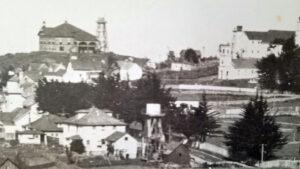by Christina Aranguren with Carol Dominy

The arrival of neighbors new to any corner of the community often means a bit of adjustment as well as discovery, so it was welcoming to learn of our new neighbors’ shared interest in local history. With that in mind, we arranged a playdate at the Kelley House Museum in order to learn what we could about our adjoining properties. To our mutual delight, we discovered that they were not just adjacent, but also related, as both pieces were once part of a larger parcel owned by local merchant, Henry Holbrook Brown (1852-1946) and his wife, Anna Christine Peterson (1866-1961). Although the original family home and barn they constructed in 1908 were dismantled circa 1965, the other Brown residence remains on Pine Street, the Craftsman-style bungalow with signature window trim, designed and built in 1914 by Henry and Anna’s only daughter, Berenice Elise, and her new husband, Dennis Ryder Davis.
Henry Brown was one of nine children from the celebrated Anderson Valley pioneer family of veterinarian-physician John Treble and nurse-midwife, Elizabeth Brown. As a young man, H. H. left the valley, finding work at the Navarro Mill before attending Heald’s Business College in San Francisco. Returning to the area, he took a position at J. E. Johnson’s store in now-gone Whitesboro on Salmon Creek south of Albion. Then, with partner Prince W. Gray, whom he met in school, they opened in 1885 their “Brown & Gray Mercantile,” which operated at two locations on Main Street for 24 years. In 1886, Henry married Anna, daughter of prominent shipbuilder Captain Thomas Peterson, in a quiet, early morning ceremony witnessed only by a few intimate friends and relatives at her parents’ home in Little River, after which generous congratulations and breakfast were served.
Henry and Annie rented a number of accommodations, including Daisy MacCallum’s house for a brief time, until they acquired their Pine Street parcel in 1907. According to the Beacon, they began building a “commodious barn” at the rear of the property between LeBallister Gulch and Evergreen Cemetery’s northern fence. There they took up residence until the completion of their large, square two-story home in 1908, where they raised three children, Leslie, Berenice, and Arnold. By all reports, theirs appears to have been a hard-working but wholesome, contented household, one where practical jokes were commonplace.
Just prior to Christmas in 1919, however, the Browns were dealt a crushing blow when Berenice passed away after a brief illness; notes in the museum files attribute her death to food poisoning. Much admired, the community was left in shock and disappointment; her funeral was attended by many. She was buried in Evergreen Cemetery and can be found alongside her parents, Henry and Annie, not far from her Pine Street bungalow.
In an exhaustive search of past issues of the Beacon kept in the museum archives, a grieving Dennis can be tracked in and around Mendocino for two or so years following Berenice’s death, during which time the bungalow was sold and then he departed for parts unknown. Census and death records were ordered that confirmed him as living in the Burlingame area as a printer (he had formerly been on the Beacon staff). He remarried and then, at 41 years of age, succumbed to a heart condition. The death documents also resolved the “?” inked on the 1977 Evergreen Cemetery map that suggested Dennis might have been buried in the Brown family plot. We now know he died in San Francisco in 1929 and was cremated at Woodlawn Cemetery in Colma.
As years went by, the cozy home they created changed hands many times, even taking in boarders, until it was eventually purchased in 1959 by Chester and Susie Gordon Walbridge. The family housed three generations there; so long a time that the charming yellow bungalow is known to this day as the “Susie Walbridge House.”
It was a difficult decision then, after nearly sixty years of family ownership, for her grandchildren to put the aging home on the market. Its future looks promising, however, as it’s been recently purchased by the Dominy family, formerly of California gold country, with the intention to carefully renovate the historic structure for their full-time residence.
As for Henry and Annie Brown’s home, it went through several owners following their 1943 departure to Philo because of their advancing age, and is reputed to have gone into decline prior to its demolition, despite Annie’s impeccable maintenance years prior. Whether a casualty of Highway 1 construction, the undergrounding of LeBallister stream, or due to the general malaise of the local economy, the property was eventually subdivided and remained largely undeveloped until 1998, when a new residence was built on the original home’s footprint. Twenty years young, a new Victorian, clad in Queen Anne pink, stands in its place. All that remains of the Brown’s occupancy are forgotten tokens the soil offers up: a child’s marble, an occasional horse shoe, a rusted hammer or file, a fishing hook, button, or spoon. We’ve found them so engaging, we intend to leave a few of our own.